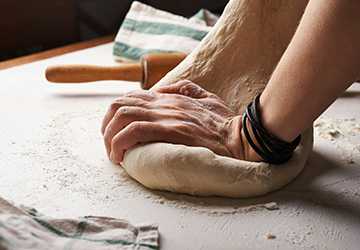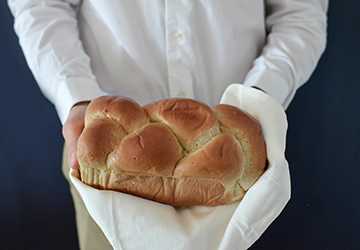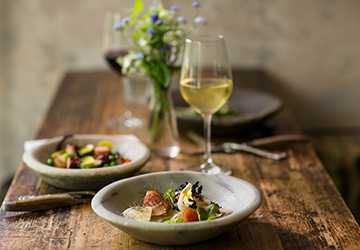In the vast expanse of the culinary universe, the art of creating artisanal bread is a monument to historical practices and inventive flair. In this discourse, we shall delve into the secrets encapsulated within artisanal bread making, dissect the intricacies of perfect bread recipes, and immerse ourselves in the quintessence of craft bakery techniques. By weaving these strands together, we aim to shepherd you towards baking bread and sculpting a masterpiece that resonates with the depths of the human spirit.

The Essence of Artisanal Bread Crafting
Grasping the Fundamentals
At the heart of artisanal breadmaking lies a deep comprehension of the primary ingredients and their symbiotic interactions. This foundational knowledge is the bedrock upon which the art of bread crafting is erected. Critical aspects include:
● The calibre of flour and its protein content
● The temperature and purity level of the water employed
● The various strains of yeast and their unique properties
● The role of salt in flavour enhancement and fermentation regulation
The Alchemy of Fermentation
The core of artisanal bread-making thrives on the alchemy of fermentation, where the enchantment truly unfolds. This phase is pivotal for imbuing the bread's characteristic taste, texture, and crust. Methods range from prolonged, chilled fermentations to more practical, temperate approaches, each bestowing distinct traits upon the finished product.
Sculpting Perfect Bread Recipes
Harmonizing Ingredients
Pursuing the perfect bread recipe is akin to many artisans' quest for culinary enlightenment. The secret to success resides in the harmonious balance of ingredients, where minor adjustments can lead to monumental changes in the outcome. Essential considerations include:
● Proportions of flour to water (hydration levels)
● Quantities of yeast and salt
● Integration of fats or sweeteners for more decadent bread varieties
Innovation and Customization
Perfect bread recipes frequently result from a blend of innovation and customization. A solid grasp of the basics permits the baker to make inventive modifications, such as adding whole grains, tweaking hydration percentages, or introducing novel flavors.
Mastering Craft Bakery Techniques
Manipulation and Moulding
Craft bakery techniques capture the physical elements of bread crafting, from kneading dough to achieve optimal gluten formation to the artistry involved in loaf shaping. Each method influences the bread's consistency, leavening, and crust.
The Art of Baking and Final Flourishes
Baking demands mastery over elements such as temperature control, timing, and the strategic use of steam. Craft bakery techniques also include scoring dough to guide its expansion and applying finishing touches like seeds or glazes to augment taste and appearance.
The Renaissance of Artisanal Bread Crafting
The Sourdough Resurgence
A key trend in artisanal breadmaking is the renewed interest in sourdough. This time-honoured technique, reliant on natural leavening agents, is celebrated for its health advantages and complex flavour profiles.
Embracing Heritage Grains
A fascination with heritage grains such as characterized and kamut also characterizes contemporary artisanal bread making. These grains offer nutritional merits and introduce distinctive flavours and textures to bread.
The Prospect of Artisanal Bread
The odyssey of artisanal bread making is constantly in flux, with each new discovery and innovation reshaping its narrative. The melding of age-old techniques with contemporary understanding and technology heralds a future where bread-making craftsmanship continues to thrive, brimming with endless avenues for creativity and excellence.

Navigating the Artisanal Bread Odyssey: Charting Unseen Territories
A Tapestry of Tastes: Venturing into Novel Aromatics
Integrating novel aromatic elements plays a crucial role in setting a loaf apart from its counterparts in the quest for excellence in artisanal bread making. Venturing into the realm of atypical ingredients for taste enhancement expands the sensory landscape and bestows each loaf with a distinct persona. Notable strategies include:
● Infusing dough with herbal essences such as rosemary or lavender, imparting a whisper of fragrance.
● Dabbling with the zest of citrus or including sun-dried fruits to inject a burst of zestful tanginess.
● Harnessing the robust flavours of ancestral grains, adding layers of nutty and earthy undertones to the bread's overall complexity.
The Moisture Ballet: Fine-Tuning Water Content
The subtle art of moisture management within artisanal bread making is a nuanced equilibrium that can revolutionise bread's internal structure and texture. Navigating and refining moisture proportions can catalycatalyzeformations in the bread's body, transitioning from light and ethereal to rich and hearty. Approaches encompass:
● Calibrating the water-to-flour ratios to secure the optimal dough texture.
● Implementing the autolyautolyzeique, a period of dough repose that bolsters gluten formation and water absorption without additional manipulation.
● Investigating doughs with elevated hydration for a crumb structure that is both open and porous, typical of ciabatta and similar rustic varieties.
The Crust's Canvas: Pioneering Outer Innovations
In artisanal bread making, the crust serves as a shield and a creative platform ripe for innovation. Perfecting the crust entails:
● UtilizUtilizing injections during baking to yield a lustrous, crisp crust.
● Modulating oven temperatures and baking durations to custom-customise thickness and hue.
● Crafting artistic scoring designs to guide the crust's expansion and enrich visual allure.
Cultural Convergence: Worldwide Bread Inspirations
Artisanal breadmaking is a conduit for cultural convergence, adopting global traditions and methodologies to inspire novel culinary creations. This cross-cultural amalgamation can produce exceptional outcomes, such as:
● Embracing the Japanese tangzhong method, known for rendering astonishingly tender and voluminous loaves.
● Incorporating the aromatic spices and seasonings of the Middle East to bestow loaves with enchanting, exotic flavours.
● Drawing from European baking heritage, rye flutilizingnatural learners deepens the flavour profile.
Conclusion
The mystique of crafting the ultimate artisanal bread is the seamless integration of science, artistry, and enthusiasm. By navigating perfect bread recipes and honing craft bakery techniques, one can embark on this gratifying voyage. Bear in mind that the soul of artisanal bread making is not merely found in the bread itself but in the passion and commitment infused into every creation. As we forge ahead, exploring and innovating, the tradition of artisanal bread crafting will persist, treasured and celebrated for generations yet to unfold.















